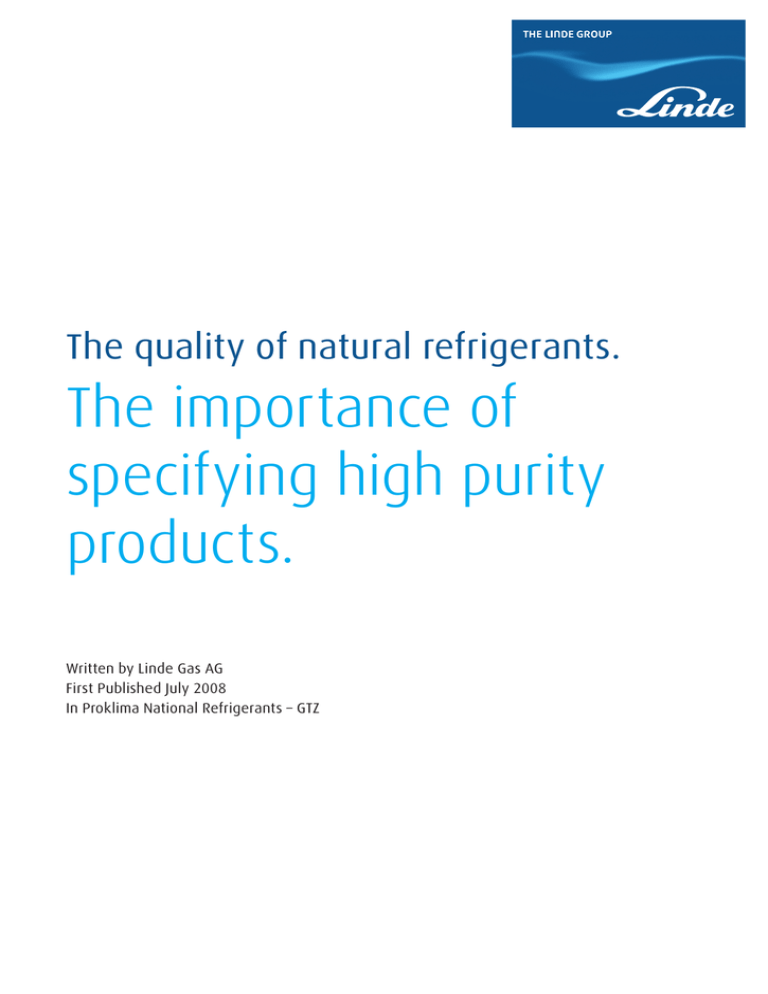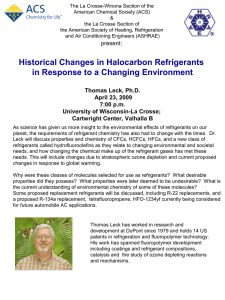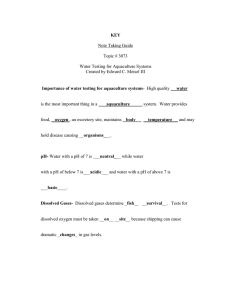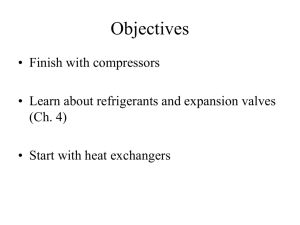The importance of specifying high purity products.
advertisement

The quality of natural refrigerants. The importance of specifying high purity products. Written by Linde Gas AG First Published July 2008 In Proklima National Refrigerants – GTZ 02 The importance of specifying high purity products. The importance of specifying high purity products. 03 Introduction. Although not a recent development, the use of natural refrigerants, ammonia (R-717/NH3), hydrocarbons (R-600a/iso-butane, R-290/ propane, R-1270/propylene, etc) and carbon dioxide (R-744/CO2) is becoming increasing common as legislation and environmental awareness shifts end-users away from fluorocarbon-based refrigerants. However, unlike most fluorocarbon refrigerants, these substances are already widely used within a variety of different applications. For example, ammonia is used for fertiliser and explosives feedstock, pharmaceutical production, and so on; hydrocarbons are typically used for fuels, but also for aerosols, foam-blowing and solvents; carbon dioxide is used extensively, from food and drink production, chemicals and pharmaceuticals production to fire extinguishers, etc. The quality requirements of a given substance vary widely depending upon the application, with some being more purity-sensitive than others. Thus, suppliers may provide products that cover an extensive range of purity specifications that are tailored to particular purposes. Many of these products are unsuitable for use as refrigerants. Thus, it is important to ensure that the ammonia, HC or CO2 is fit for purpose, and confirms to the specifications appropriate for use as refrigerants. For fluorinated refrigerants, the commonly adopted standards are AHRI 700 (which is inappropriate for natural refrigerants) and DIN 8960. DIN 8960 also covers HCs and ammonia, and the IIAR Specification O-A-445B for ammonia. In addition, a number of compressor manufacturers specify certain requirements for the refrigerants that are to be used in their machines. However, due to the absence of an international standard on the quality of natural refrigerants and widespread retailing of products sold as ammonia, HCs and carbon dioxide refrigerants, there is a major disparity in their quality. As a result, the purchaser or end user must rely on the refrigerant supplier to provide an adequate material, and unless the purchaser specifies the application to the vendor, the most common, which is also generally the lowest purity product, will be sold. In some cases vendors may openly offer lower grade material in order to be more competitive. Similarly, if the technicians are unaware of the importance of refrigerant purity, they may quite easily purchase sub-standards products, such as LPG instead of R-290. Using low grade natural refrigerants can ruin the performance and reliability of a refrigeration system and cause serious damage to equipment. Whilst some reports have demonstrated that low quality ammonia, CO2 and HCs have been successfully used in refrigeration systems, there are also many instances of equipment failure and poor performance occurring under the same situations. Therefore, this article details the potential implications of using low quality fluids as refrigerants, and emphasises the importance of using the correct specifications. 04 The importance of specifying high purity products. The importance of specifying high purity products. 05 Implications of refrigerant contamination. There are four main impacts associated with the use of impure refrigerants with a system: • Changes to the thermophysical properties of the working fluid. • Chemical changes affecting the internal stability of the system. • Physical changes that affects the structure of components and behaviour of materials. • Toxicity implications if released from the system. Many of the changes are interrelated and all ultimately compromise the performance, operation, longevity and safety of the system. If the refrigerant is contaminated with a gas which has good mutual solubility, a mixture is created and if the proportions are high enough, the properties, and in particular, the saturated pressure-temperature relationship can be altered. Conversely, if a gas readily separates from the refrigerant, it may accumulate within certain high-side components and therefore inhibit heat transfer, thereby degrading system performance. Changes to the thermodynamic and transport properties of the fluid will occur if the refrigerant is contaminated with substances with which it is mutually soluble, in sufficiently high proportions. Introduction of certain substances changes the internal chemistry of the system making it less stable. Examples of the consequences to the system arising from chemical changes include: Examples of the consequences to the system arising from changes in properties include: • Reactions that produce sludge, thereby blocking components and affecting heat transfer. • Reactions the result in acids that attack the construction materials, such as metals, plastics and elastomers. • Formation of new gases that are a product of reactions that can again affect the thermophysical properties of the refrigerant. • Variation in suction and discharge pressures for a given evaporating and condensing temperature compared to standard data. • Creation of a temperature glide, or a deviation from the standard temperature glide data, within the evaporator or condenser. • Increased or decreased solubility with the lubricating oil, possibly resulting in poorer lubricity or starving of oil from the compressor • Fluid separation within the circuit, where higher pressure com­ponents accumulate within the high-side of the system and lower pressure components accumulate within the low-side. • Changes in refrigerant enthalpy and interference with heat transfer and pressure losses with heat exchangers and other components resulting in a moving of the system balance points. The physical impacts to the internal operation of the system include: • Increasing levels of moisture become insoluble with the refrigerant at certain temperatures and pressures, resulting in the formation of ice, typically within the expansion device. • Adsorption of substances into plastics and elastomers, thereby changing their physical properties and reducing their ability to seal properly. • Reduction in lubricating properties leading to erosion and subsequent formation of metallic debris which leads to further wearing of moving parts. The implications on safety include: • Increase in operating pressures, which may exceed the design working pressures of the components or assembly. • Higher system pressures, corrosion and poorer sealing properties of elastomeric materials lead to a higher possibility of leakage and rupture of components. • The release of toxic, flammable and/or corrosive fluids that were not previously anticipated. All of the above consequences of the introduction of undesirable substances into the refrigerating system will lead to a combination of reduced cooling capacity, increased power consumption, a drop in efficiency, increased likelihood of leakage, failure of moving parts and a general mechanical degradation of the system components. In order to determine the suitable specifications for natural refrigerants, it is necessary to analyse the effects that each are likely to comprise. 06 The importance of specifying high purity products. The importance of specifying high purity products. Carbon dioxide. Hydrocarbons. Figure 1: Vapour / liquid composition ratio of various gases in CO2 at 0 °C Figure 2: Solubility of moisture in hydrocarbons 20 isobutane 20 07 propane 1000 15 100 11 11 10 10 5,7 5 1,7 0 hydrogen oxygen nitrogen methane ethane 0,6 0 -40 propane -20 0 20 40 Introduction Air; oxygen and nitrogen Introduction Water Carbon dioxide is already used in a massive range of applications, from food and drink production, drinks dispensing, chemicals and pharmaceuticals production, fire extinguishers, and so on, and therefore the range of specifications is similarly extensive. Carbon dioxide is also sources from a large number of production methods, which include being a by-product from ammonia and hydrogen plants, from the combustion of wood and fossil fuels, as a by-product of fermentation in breweries, and from thermal decomposition of limestone for production of lime. Thus, the most common substances found in carbon dioxide include water, air, carbon monoxide, hydrogen and hydrocarbons. Whilst oxygen and nitrogen are unreactive with carbon dioxide, oxygen will promote reactions with any other substance likely to be present in the system, especially on the high pressure side where it is likely to collect. Otherwise, the high vapour pressure of these gases means that they will have a negative impact on the performance of the refrigerating system, and therefore their composition must be limited. Figure 1 shows the ratio of vapour composition of various gases in CO₂ to their composition in liquid CO₂ which provides an indication of the detriment that the presence of a particular gas will have on the cycle performance. This shows that a significant amount of oxygen and nitrogen will separate out, typically in the condenser and receiver, which will degrade system performance, although this effect becomes less important during super-critical operation. The most commonly used hydrocarbon is LPG for industrial, commercial, agricultural and domestic fuel where purity is not a significant factor. Other applications requiring higher purity hydrocarbons include aerosol propellants and calibration mixtures. It is important to recognise that LPG has a very random composition, for example, a cylinder of “propane” may only contain 50 % propane with the remainder being made up of a variable mixture of other hydrocarbons plus high levels of sulphur, water and air. The presence of moisture encourages reactions, such as creation of acids and subsequently corrosion, which is undesirable for good reliability of the system components. Water will also react with other substances to form weak organic acids, which eventually react with oil to form soapy sludge that can deposit throughout the system causing blocking and operational problems. In addition, hydrocarbons are largely insoluble with water, as seen in Figure 2. At lower temperatures less water will be held in the refrigerant, so that as the refrigerant reduces in temperature excess water may form ice, which is undesirable for the operation of the refrigerating system. Considering that HCs may be used in systems that have evaporating temperatures down to –40 °C, the data in Figure 2 suggests very low moisture content is desirable. Water Water easily reacts with carbon dioxide to form carbonic acid, which in contact with metal causes corrosion. In Sweden the national research institute, EUC laboratory, carried out extensive tests using various grades of CO₂ and found severe problems including compressor failure caused by high moisture levels. Following their recommendation the Swedish refrigeration industry standard for R744 has agreed a moisture content of no more than 10 ppm. This standard has become the norm in many other Northern European countries. In addition, water has a low solubility in carbon dioxide and as such, it easily separates out as free water or ice and the pressure and temperature decrease. Hydrocarbons The hydrocarbons are relatively unreactive with carbon dioxide, they are soluble with the oils typically used with CO₂ and the saturated HCs are relatively benign when in contact with elastomers. In terms of their effect on vapour pressure, methane, ethane and propane introduce only minor differences to the vapour pressure even in relatively high concentrations, such as 1 % change in pressure per 1 % of introduced hydrocarbon. Further, as seen in Figure 1, the vapour / liquid composition ratio of the hydrocarbons in CO₂ is relatively low indicating that fractionation within the circuit is likely to be small and therefore will have minimal degradation of performance. The commonly used hydrocarbons originate from natural gas or oil, and when first extracted tend to come in a mixture with many other components. Generally, these include sulphur compounds, oil and air. Sulfur Sulphur may be present naturally, or added in the form of mercaptans (thiols). Whilst the concentrations will be sufficiently low to not affect the vapour pressure of the refrigerant, they can promote reactions within the system, leading to creation of acids and copper plating on the compressor parts, especially if water or oxygen is present. Another implication of having mercaptans present in the refrigerant is the possible confusion arising from the association of its smell to that of a fuel gas release. Hydrogen sulphide is somewhat reactive, but also highly toxic and it is therefore desirable to ensure that it is absent from the product. Benzene, butadiene, propadiene (allene) Benzene, butadiene and propadiene are all highly carcinogenic and toxic and are controlled substances in most countries. These are the main reasons for eliminating them from the refrigerants. Also, whilst benzene is relatively unreactive with other system materials, butadiene and propadiene readily polymerise when oxygen and acid are present. 08 The importance of specifying high purity products. The importance of specifying high purity products. 09 Ammonia. Figure 3: Vapour / liquid composition ratio of various gases in propane at 0 °C Figure 4: Eutectic curve for ammonia / water mixtures 250 Figure 5: Vapour pressure of ammonia and water mixture at –36 °C Concentration of water in liquid ammonia (kg/kg) Concentration of ammonia in water (kg/kg) 223 1.0 0 200 -20 150 0.8 -40 -60 90 100 0.6 0.4 -80 50 9,5 0 oxygen nitrogen CO₂ 3,9 methane 0.2 -100 27 ethane 1,3 propylen 0,4 isobutan -120 0 0,2 0,4 0,6 0,8 1 Air; Nitrogen, oxygen and carbon dioxide Other hydrocarbons Introduction Whilst nitrogen and carbon dioxide are relatively unreactive with hydrocarbons under the likely operating conditions, oxygen does of course promote reactions with almost any other substance likely to be present in the refrigerant, especially on the high pressure side, where it is likely to collect. Also, for all of these gases, their high vapour pressure of means that they will have a negative impact on the performance of the refrigerating system, and therefore their composition must be limited. Specifically for oxygen and nitrogen, it is seen in Figure 3 that a high degree of separation between the liquid and vapour compositions occurs, implying that significantly high amounts of these gases will collect in the high side of the system even if only low levels are present in the liquid refrigerant. Notwithstanding, the presence of carbon dioxide is a lot less severe. Mixtures containing other hydrocarbons will affect the vapour pressure, especially with the introduction of gases with a significantly different partial pressure from the main refrigerant; typically these include high normal boiling point (NBP) HCs such as pentane and hexane, and low NBP HCs such as ethane and methane (Figure 3). These will collect in the low and high pressure sides of the system, respectively, thereby increasing discharge pressures and reducing suction pressures, introducing high temperature glides and ultimately compromising the system performance. Therefore it is important to ensure that the permissible mixture of the other HCs is kept within a certain limit, and that the presence of high NBP components is offset by the presence of low NBP components to minimise their individual effects. In terms of other impacts, having unsaturated HCs (such as propylene or ethylene) present in a saturated HC refrigerant can lead to problems with certain elastomers (e. g., neoprene) unless they have been selected to handle all such components. Ammonia can be obtained from a variety of sources. Traditionally, it was produced from the distillation of vegetable and animal waste products, but large-scale modern production is typically by obtaining hydrogen from natural gas or oil, and reacting it with atmospheric nitrogen. Accordingly, the production process largely influences the types of contaminants found in ammonia, which typically include, amongst others: oxygen, carbon dioxide, hydrogen sulphide, methane and other volatile hydrocarbons, methanol, nitrogen, oil and heavy hydrocarbons, sulphur dioxide and water. The implications of these are discussed below. Water The presence of moisture encourages reactions, creating acids and subsequent corrosion, which is undesirable for good reliability of the system components. In the presence of moisture, ammonia can react with and corrode steel, copper, zinc, and many alloys although oil produces a film over internal surfaces which can effectively insulate metal surfaces against corrosion. Water will also react with other substances to form weak organic acids, which eventually react with oil to form a soapy sludge that can deposit throughout the system causing 0.0 0 0.2 0.4 0.6 0.8 1.0 blocking and operational problems. Therefore an absence of moisture is preferred. Conversely, it is also reported that a small quantity of moisture is necessary to deter stress corrosion cracking (SCC) in steel particularly if oxygen is present. In addition to chemical reactions, there are other thermodynamic and physical effects caused by water, such as icing, loss of performance and erosion. In terms of icing, ammonia is very different from CO₂ and hydrocarbons because of its good solubility with water, and a low eutectic temperature of the mixture. Figure 4 shows the (rather unusual) eutectic curve of ammonia and water, which demonstrates that a very high concentration of water (above 80 %) is required to produce ice under normal operating conditions; although of course at such concentrations, the saturation pressure would be extremely low. However, if the change in vapour pressure of an ammonia-water mixture is considered (Figure 5) the effect on system performance can be significant, and notable deterioration can occur at concentrations above 1 %. Anecdotal reports suggest that water content causes erosion to valves and other components, through increased cavitation when passing through orifices, and the effect of particulates such as rust (initially caused by the water). 10 The importance of specifying high purity products. The importance of specifying high purity products. 11 Final remarks. Air; oxygen, carbon dioxide and nitrogen Methane and the other hydrocarbons The presence of air will promote reactions with almost any other substance likely to be present in the ammonia, especially on the high side of the system (where it is likely to collect) given the high pressure/temperature conditions. Additionally, oxygen of more than a few ppm in liquid ammonia or a few hundred ppm in gaseous ammonia can promote stress corrosion cracking (SCC) in carbon and low-alloy steels, and this is amplified at high pressures and high temperatures. These gases are likely to be present but are relatively benign and will not react under normal system operating conditions. However, the higher partial pressure of methane and ethane means that in sufficient proportions, they could impact on the performance of the refrigerating system. In particular, they have unusual characteristics when mixed with ammonia, and under certain compositions form metastable azeotropes which mean that the effect on system performance is difficult to anticipate. CO₂ can react with ammonia to produce ammonium carbonate, and this is highly corrosive to steel. It is also reported that carbon dioxide in ammonia increases the chance of SCC. Nitrogen, along with oil and water cause nitriding, or the creation of weak acids, which lead to formation of sludge and corrosion. Therefore it is desirable to minimise concentrations of nitrogen. Also, the high pressure of nitrogen means that it will have a negative impact on the performance of the refrigerating system. Methanol Methanol is relatively stable in the presence of ammonia, so it will not decompose or create any undesirable substances. However, it has a NBP much higher than ammonia and therefore its presence has a similar effect to water, although the performance of a refrigerating system will be tolerant of methanol up to relatively high concentrations. Sulfur Sulphur dioxide and hydrogen sulphide react with water and ammonia to form acids, which can lead to severe corrosion. The purity of natural refrigerants is as yet largely uncontrolled in terms of availability of international standards, yet it is evident that ensuring the use of high-specification product is essential to maintain system integrity. This is important for all the natural refrigerants, but is more so for hydrocarbons and carbon dioxide; using low quality gases can compromise both the reliability of the system and its performance on terms of cooling capacity and efficiency. Random analyses of various suppliers’ natural refrigerant products have revealed a wide range of qualities, varying from very high purity, to products that contain a large number of gaseous contaminants, oil and water. The presence of contaminants in a system can result in a variety of negative effects, including: • Changes to the thermophysical properties of the working fluid. • Chemical changes affecting the internal stability of the system. • Physical changes that affects the structure of components and behaviour of materials. • Toxicity implications if released from the system. Therefore, when purchasing any natural refrigerant, it is of utmost importance to ensure that it is of a high specification and supplied in a cylinder used exclusively for that service. Similarly, end-users and system owners should be made aware that refrigeration-grade natural refrigerants exist, and that if not specified they could be risking degradation to system performance and operation, compromising reliability and introducing unnecessary safety risks. Getting ahead through innovation. With its innovative concepts, Linde is playing a pioneering role in the global market. As a technology leader, it is our task to constantly raise the bar. Traditionally driven by entrepreneurship, we are working steadily on new high-quality products and innovative processes. Linde offers more. We create added value, clearly discernible competitive advantages, and greater profitability. Each concept is tailored specifically to meet our customers’ requirements – offering standardised as well as customised solutions. This applies to all industries and all companies regardless of their size. If you want to keep pace with tomorrow’s competition, you need a partner by your side for whom top quality, process optimisation, and enhanced productivity are part of daily business. However, we define partnership not merely as being there for you but being with you. After all, joint activities form the core of commercial success. Linde – ideas become solutions. References 1. ISO/NP 12810, Fluorocarbon refrigerants – Specifications and test methods. 2. AHRI 700-2012, Specifications for Fluorocarbon Refrigerants, Air-Conditioning and Refrigeration Institute, USA, Jan, 2012. 3. DIN 8960 Kaeltemittel – Anforderungen und Kurzzeichen, Deutsches Institut Fur Normung E.V., Nov, 1998. 4. IIAR Specification for Ammonia Specification O-A-445B, International Institute for Ammonia refrigeration, 1110 North Glebe Road, Arlington, VA 22201, USA. 5. Lemmon, EW, Huber, ML, McLinden, MO. NIST Reference Fluid Thermodynamic and Transport Properties – REFPROP. Version 8.0. National Institute of Standards and Technology, Boulder, USA. April 2007. Linde AG Linde Gases Division, Seitnerstrasse 70, 82049 Pullach, Germany Phone +49.89.7446-2339, Fax +49.89.7446-2071, www.linde-gas.com/refrigerants





